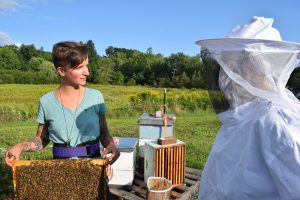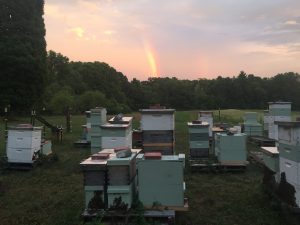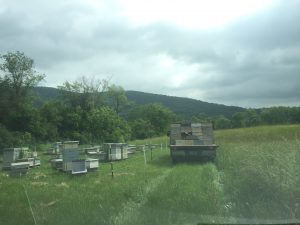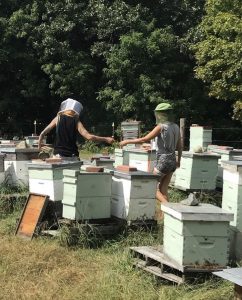Apiary Action Plan
Download and print the Apiary Action Plan as a PDF.
Download and print the Apiary Action Plan Steps as a PDF.
Apiary Action Plan Guide created by Ang Röell, They Keep Bees, Winter 2020

In this activity, you will apply all you’ve learned in the field about biology, management and practice to create an Apiary Action Plan.
In this plan, you’ll consider and articulate details about your goals as an Apiculturist (beekeeper), set goals for your apiary, identify cost, think about siting new and mating yards, and make a decision about management / practice.
You will use the model to create an apiary expansion plan for how you will systemize your current apiary and expand upon the practices within it. This will include adding a queen rearing system or increase management plan, creating a calendar and record keeping system, and adapting a new management strategy or changing systems that are not working for you currently.

Step 1: Set A Holistic Goal for your Apiary
What is a holistic goal? (Source: Purple Pitch Fork)
The term “holistic goal” comes from a school of thought called Holistic Management. It is a three-part goal describing the quality of life desired, the forms of production to get there, and the future resource base that the forms of production depend on. Whether or not you practice Holistic Management, a written goal can be a powerful instrument for building understanding and cooperation in an apiary.
The power of Holistic Management process lies in the goal. Work that fulfills the commitment we have to ourselves, our families, our environment and our communities can only succeed in the context of a journey toward a holistic goal.
The holistic goal is a living document. In the journey of our lives, without knowing where we are going, we cannot know how to begin. A goal provides us with the knowledge we need to move with confidence, because with a goal: We know the direction to go (plan); We have a way to measure our progress (monitor); We can correct our course when things go wrong (control); We can get back on course when big things go wrong (replan). A goal doesn’t have to be beautiful. You don’t have to type it on the computer with four different fonts, bolded and italicized. The sentences don’t have to be complete. The motives don’t have to be lofty. The only requirement is that it works. The most challenging aspect of formulating a written holistic goal is actually doing it. The process has none of the instant gratification of chopping wood, extracting honey, or pulling weeds, (or even the gratification of financial or biological planning) but it guides and informs our decisions about how, when, and whether to do each of these tasks.

Your Holistic Goal Answers These Questions:
-
-
What do you want?
-
How will you get there?
-
What “being state” do you wish to bring to the project? What energy do you wish to bring to the work?
-
What are the needs of the project? What are the yields of your project?
-
How do they impact your close friends, family or collective, community, world?
-
Who/what are your allies/resources?
-
What knowledge do you bring?
-
What knowledge do you need? How will you acquire it?
-
What are your predators or impediments?
-
What relationship do you want with your bees? What impacts will your choices have on the bees, the greater ecology?
-

Step 2: Creating a Plan to Start or Expand an Apiary
- What do you need to expand an apiary? Make a list of all of the items you’ll need. What is your start-up cost?
OR What is your expansion cost?
- Make a list of the items you need for: protective equipment, hive manipulation equipment and pieces of the hive. Outline the costs. How will you purchase these? Through which suppliers?
- How many colonies will you start with or expand to? Why?
- Discuss the pros and cons of 2 ways you could obtain bees to expand a beekeeping hobby or operation.
- What size brood and honey super boxes would you use for expansion?
- Will you customize any equipment? Which parts? How?
- What would be advantages of customizing some of the requisite pieces of equipment?

Step 3: Site the Apiary
- Where will you establish your apiary or new yards?
- Select a location in your area on which you’d like to site honey bees. Describe the best features of the site.
What might you do to overcome the most negative aspects of the site? - What infrastructure do you need in place to keep bees at this location?
- What considerations of neighbors might take precedence over beekeeper’s point of view?
- How will you approach neighbors and institutions to discuss apiary location?
- How will you come to an agreement with neighbors about your practice (beekeeping) and their pesticide applications? How will you address fears/anxiety about having an apiary sited nearby?

Step 4: Managing the Apiary
- Outline 1 season of management from April-November below. What tasks do you need to complete each month? Week?
- How will you implement each step month-to-month?
- When will you inspect?
- What will you look for in Spring, Summer, Fall, Winter?
- What is your treatment and/or manipulation plan? Why?
- How did you decide upon this plan? Cite a minimum of 5 resources that informed this decision.
- Where will you purchase your stock? How? Why?
- How will you keep records? Count mites? When? What will inform your treatment decisions? Cite 2 resources for determining what threshold of mites should be present to determine treatment.
Media Attributions
- Ang Roell holding beehive frame © Ang Roell is licensed under a CC BY-NC (Attribution NonCommercial) license
- Dandelions © Ang Roell is licensed under a CC BY-NC (Attribution NonCommercial) license
- Goal Setting Framework © Ang Roell is licensed under a CC BY-NC (Attribution NonCommercial) license
- Apiary at dusk © Ang Roell is licensed under a CC BY-NC (Attribution NonCommercial) license
- Distance shot of apiary © Ang Roell is licensed under a CC BY-NC (Attribution NonCommercial) license
- Close-up of apiary © Ang Roell is licensed under a CC BY-NC (Attribution NonCommercial) license


Feedback/Errata